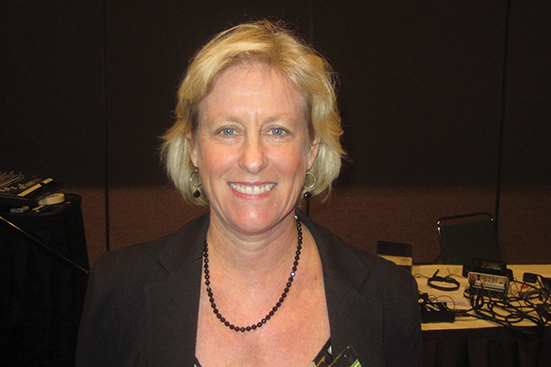User login
SEATTLE – Routine atropine is "optional, not standard" for preventing reflex bradycardia in children during rapid-sequence intubation, according to Dr. Marianne Gausche-Hill, associate professor of emergency medicine at the University of California, Los Angeles.
A common-sense guideline is to have atropine available in case you need it, she said. If bradycardia occurs, "the first thing I do ... is stop the intubation and begin bag-mask ventilation, and then, if they don’t respond, atropine is a reasonable choice," she said at the annual meeting of the American College of Emergency Physicians (ACEP).
Dr. Gausche-Hill uses a high-dose nasal cannula during the apneic period to prevent hypoxia – 5 L/min in neonates and young children, and 15 L/min in older children – and correct hypovolemia, when possible, before intubation. She also uses suction to deal with secretions.
When atropine is needed during rapid-sequence intubation (RSI), Dr. Gausche-Hill opts for a dose of 0.01-0.02 mg/kg for infants under 5 kg, based on research that found that dose to be both safe and effective (Pediatrics 2011;127:783-4).
"Atropine can prevent bradycardia associated with the administration of succinylcholine, but we don’t know how effective that is in the face of hypoxia. It appears that hypoxia is really the issue here, and not forgoing pretreatment with atropine," she said, echoing a meta-analysis of the issue (Emerg. Med. J. 2007;24:361-2).
Increasingly, emergency departments are not routinely using atropine in pediatric RSI, but the approach hasn’t been adopted everywhere, according to an informal poll taken during Dr. Gausche-Hill’s presentation at the ACEP Scientific Assembly.
In addition, Advanced Pediatric Life Support (APLS) guidelines recommend routine use of atropine in infants under 1 year old, in children 1-5 years old who receive succinylcholine, and in older children who receive a second dose of succinylcholine during RSI, she said.
The notion that children need atropine to prevent reflex bradycardia is based on pediatric surgery studies using inhaled anesthetics and succinylcholine. Researchers "felt that with those inhalation anesthetics, atropine would decrease bradycardia associated with use of high-dose succinylcholine, [but] we are not using those inhalation agents, which may in themselves have resulted in mild hypoxia and bradycardia," she said.
In one study, atropine made no difference in pediatric RSI. Among 68 young children who got atropine, 3 became bradycardic, as did 3 of 75 other children who didn’t get atropine (Pediatr. Emerg. Care 2004;20:651-5).
It appears hypoxia, not forgoing pretreatment with atropine, is a strong predictor of patients who will develop reflex bradycardia, she said.
Further, atropine masks the ability to monitor heart rate changes; increases the risk of ventricular arrhythmias; relaxes the lower esophageal sphincter, possibly increasing the risk of aspiration; and increases temperature and the risk of malignant hyperthermia.
Dr. Gausche-Hill had no relevant disclosures.
SEATTLE – Routine atropine is "optional, not standard" for preventing reflex bradycardia in children during rapid-sequence intubation, according to Dr. Marianne Gausche-Hill, associate professor of emergency medicine at the University of California, Los Angeles.
A common-sense guideline is to have atropine available in case you need it, she said. If bradycardia occurs, "the first thing I do ... is stop the intubation and begin bag-mask ventilation, and then, if they don’t respond, atropine is a reasonable choice," she said at the annual meeting of the American College of Emergency Physicians (ACEP).
Dr. Gausche-Hill uses a high-dose nasal cannula during the apneic period to prevent hypoxia – 5 L/min in neonates and young children, and 15 L/min in older children – and correct hypovolemia, when possible, before intubation. She also uses suction to deal with secretions.
When atropine is needed during rapid-sequence intubation (RSI), Dr. Gausche-Hill opts for a dose of 0.01-0.02 mg/kg for infants under 5 kg, based on research that found that dose to be both safe and effective (Pediatrics 2011;127:783-4).
"Atropine can prevent bradycardia associated with the administration of succinylcholine, but we don’t know how effective that is in the face of hypoxia. It appears that hypoxia is really the issue here, and not forgoing pretreatment with atropine," she said, echoing a meta-analysis of the issue (Emerg. Med. J. 2007;24:361-2).
Increasingly, emergency departments are not routinely using atropine in pediatric RSI, but the approach hasn’t been adopted everywhere, according to an informal poll taken during Dr. Gausche-Hill’s presentation at the ACEP Scientific Assembly.
In addition, Advanced Pediatric Life Support (APLS) guidelines recommend routine use of atropine in infants under 1 year old, in children 1-5 years old who receive succinylcholine, and in older children who receive a second dose of succinylcholine during RSI, she said.
The notion that children need atropine to prevent reflex bradycardia is based on pediatric surgery studies using inhaled anesthetics and succinylcholine. Researchers "felt that with those inhalation anesthetics, atropine would decrease bradycardia associated with use of high-dose succinylcholine, [but] we are not using those inhalation agents, which may in themselves have resulted in mild hypoxia and bradycardia," she said.
In one study, atropine made no difference in pediatric RSI. Among 68 young children who got atropine, 3 became bradycardic, as did 3 of 75 other children who didn’t get atropine (Pediatr. Emerg. Care 2004;20:651-5).
It appears hypoxia, not forgoing pretreatment with atropine, is a strong predictor of patients who will develop reflex bradycardia, she said.
Further, atropine masks the ability to monitor heart rate changes; increases the risk of ventricular arrhythmias; relaxes the lower esophageal sphincter, possibly increasing the risk of aspiration; and increases temperature and the risk of malignant hyperthermia.
Dr. Gausche-Hill had no relevant disclosures.
SEATTLE – Routine atropine is "optional, not standard" for preventing reflex bradycardia in children during rapid-sequence intubation, according to Dr. Marianne Gausche-Hill, associate professor of emergency medicine at the University of California, Los Angeles.
A common-sense guideline is to have atropine available in case you need it, she said. If bradycardia occurs, "the first thing I do ... is stop the intubation and begin bag-mask ventilation, and then, if they don’t respond, atropine is a reasonable choice," she said at the annual meeting of the American College of Emergency Physicians (ACEP).
Dr. Gausche-Hill uses a high-dose nasal cannula during the apneic period to prevent hypoxia – 5 L/min in neonates and young children, and 15 L/min in older children – and correct hypovolemia, when possible, before intubation. She also uses suction to deal with secretions.
When atropine is needed during rapid-sequence intubation (RSI), Dr. Gausche-Hill opts for a dose of 0.01-0.02 mg/kg for infants under 5 kg, based on research that found that dose to be both safe and effective (Pediatrics 2011;127:783-4).
"Atropine can prevent bradycardia associated with the administration of succinylcholine, but we don’t know how effective that is in the face of hypoxia. It appears that hypoxia is really the issue here, and not forgoing pretreatment with atropine," she said, echoing a meta-analysis of the issue (Emerg. Med. J. 2007;24:361-2).
Increasingly, emergency departments are not routinely using atropine in pediatric RSI, but the approach hasn’t been adopted everywhere, according to an informal poll taken during Dr. Gausche-Hill’s presentation at the ACEP Scientific Assembly.
In addition, Advanced Pediatric Life Support (APLS) guidelines recommend routine use of atropine in infants under 1 year old, in children 1-5 years old who receive succinylcholine, and in older children who receive a second dose of succinylcholine during RSI, she said.
The notion that children need atropine to prevent reflex bradycardia is based on pediatric surgery studies using inhaled anesthetics and succinylcholine. Researchers "felt that with those inhalation anesthetics, atropine would decrease bradycardia associated with use of high-dose succinylcholine, [but] we are not using those inhalation agents, which may in themselves have resulted in mild hypoxia and bradycardia," she said.
In one study, atropine made no difference in pediatric RSI. Among 68 young children who got atropine, 3 became bradycardic, as did 3 of 75 other children who didn’t get atropine (Pediatr. Emerg. Care 2004;20:651-5).
It appears hypoxia, not forgoing pretreatment with atropine, is a strong predictor of patients who will develop reflex bradycardia, she said.
Further, atropine masks the ability to monitor heart rate changes; increases the risk of ventricular arrhythmias; relaxes the lower esophageal sphincter, possibly increasing the risk of aspiration; and increases temperature and the risk of malignant hyperthermia.
Dr. Gausche-Hill had no relevant disclosures.
EXPERT ANALYSIS AT THE ACEP SCIENTIFIC ASSEMBLY 2013

